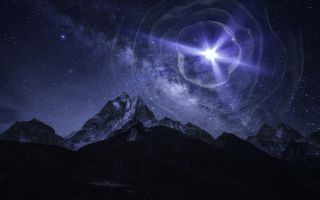A 'strange signal' is coming from the Milky Way. What's causing it?
- Get link
- X
- Other Apps
By David Crookes , All About Space magazine
Space Mysteries: A fast radio burst was detected from within our galaxy for the first time. We may be closer to uncovering its origin.


This article is brought to you by All About Space.
All About Space magazine takes you on an awe-inspiring journey through our solar system and beyond, from the amazing technology and spacecraft that enables humanity to venture into orbit, to the complexities of space science.
On April 28, 2020, two ground-based radio telescopes detected an intense pulse of radio waves. It only lasted a mere millisecond but, for astonished astronomers, it was a major discovery, representing the first time a fast radio burst (FRB) had ever been detected so close to Earth.
Located just 30,000 light-years from our planet, the event was firmly within the Milky Way, and it was, to all intents and purposes, almost impossible to miss. The Canadian Hydrogen Intensity Mapping Experiment (CHIME) and the Survey for Transient Astronomical Radio Emission 2 (STARE2) certainly had no problems picking it up. "CHIME wasn’t even looking in the right direction and we still saw it loud and clear in our peripheral vision," said Kiyoshi Masui, assistant professor of physics at the Massachusetts Institute of Technology. "STARE2 also saw it, and it’s only a set of a few radio antennae literally made out of cake pans."
Until that point, all FRBs had been observed outside our galaxy. "They’ve been billions of light years away, making them a lot harder to study," said doctoral candidate in physics Pragya Chawla from McGill University in Canada. April 2020’s discovery was also notable for being the most energetic radio blast that astronomers have ever recorded in the Milky Way, but what made it most exciting is that scientists are now closer to determining the origin of FRBs than at any point since they were first discovered.
That happened in 2007, when Duncan Lorimer and David Narkevic were studying data taken by the Parkes radio dish in Australia. Discovering an FRB so close to home has been the breakthrough astronomers have wished for ever since. "We can learn more from a source that’s 30,000 light-years away than one that’s a billion or more light-years’ distance," Masui affirms. "We finally have a nearby source to study."
One of the major problems with detecting FRBs, aside from most of them having been so far away, is that they are so fleeting. They’ve been and gone in the blink of an eye despite being 100 million times more powerful than the sun — they can release as much energy in a few thousandths of a second as the sun in 100 years. Ideally, astronomers would discover an object and focus one or more different telescopes at it, but the ephemeral nature of these bursts removes any such opportunity.
But despite these challenges, astronomers have succeeded in building up a bank of knowledge about FRBs, most of which has been based on the dozens of recorded events from beyond our own galaxy. For starters, we know they are bright flashes of radio light lasting for microseconds to milliseconds. "All-sky searches for them also suggest that thousands of these bursts occur in the sky every day," Chawla added.

We also know that most of them come from billions of light-years away. But while dozens of models have been proposed to explain the origins of FRBs — with progenitors ranging from neutron stars to white dwarfs to cosmic strings — have any theories really prevailed? "Well, we know that they come from very small sources — no more than a few hundred kilometres in size," Masui said. "And the most likely sources are neutron stars since they are both very small and very energetic."
The FRB discovered in the Milky Way is now helping astronomers to firm up such theories, and it’s become something of a breakthrough for scientists trying to get to the bottom of what is causing them.
Thanks to some nifty cosmic detective work involving the data of other telescopes monitoring the same patch of sky, observational evidence is now suggesting that the origin of FRBs is very likely a magnetar, a type of young neutron star born from the embers of supernovas with a magnetic field 5,000 trillion times more powerful than Earth’s, thereby making them the universe’s most powerful magnets.

But how has this conclusion been drawn? To explain, we must consider the work that has gone into studying FRBs in relation to magnetars, which are known to emit high-energy electromagnetic radiation, notably gamma rays and X-rays. Both of these erupt in short-lived flares, and there has been speculation that radio waves could be emitted in such a process that would pinpoint magnetars as the source for FRBs.
When this latest FRB was discovered in our galaxy — known by astronomers as FRB 200428 — it was found to have originated in the constellation of Vulpecula, which just so happens to be where the galactic magnetar SGR 1935+2154 is located. It was also accompanied by a burst of X-rays that further excited astronomers.
The first detection of X-rays from that sky region came the day before CHIME and STARE2 discovered FRB 200428. The Neil Gehrels Swift Observatory and the Fermi Gamma-ray Space Telescope detected multiple X-ray and gamma-ray bursts coming from SGR 1935+2154, which was known to exhibit transient radio pulsations.
Other telescopes were also found to have observed an X-ray burst from SGR 1935+2154 — crucially, at the same time as the fast radio burst. These included the Konus-Wind detector on board NASA’s GGS-Wind spacecraft and the European Space Agency’s INTEGRAL space telescope, both picking up an X-ray burst at the moment CHIME and STARE2 recorded the FRB.
How CHIME is used to discover fast radio bursts
Located in Okanagan Falls, the Canadian Hydrogen Intensity Mapping Experiment picked up on FRB 200428.
For another check, attention turned to the Five-hundred-meter Aperture Spherical Radio Telescope (FAST) located in southwest China. This fixed-diameter dish telescope detected a fast radio burst in the direction of FRB 200428 and put its location somewhere around SGR 1935+2154, which further cemented the association between the X-ray source and fast radio bursts. The latter was comparable to other FRBs found outside the Milky Way, adding to the body of evidence.
"What this means is that the FRB came from the direction of a known magnetar within our galaxy and the radio burst happened at exactly the same time as an X-ray burst coming from the same magnetar," Masui said. "It’s a clue as to how magnetars produce FRBs, but the community is still trying to work out what it all means."
What has become clear is that FRB 200428 is the first observed fast radio burst to send out emissions other than radio waves, and scientists have benefitted hugely from having discovered an FRB so close to home. The detection of the X-ray burst at the same time as the radio burst confirmed a magnetar as the origin, and it’s the evidence astronomers have been looking for.
"The discovery of an FRB in our galactic neighborhood is significant because the proximity makes it a lot easier to follow up the source with telescopes observing at other wavelengths," Chawla said. "None of the FRBs ever discovered have been known to emit at any other wavelengths, and this is the first detection of an FRB at a different wavelength. These observations can probe the source environment in greater detail, providing clues about the origin of FRBs."
CHIME in particular has proven to be an essential tool. Based at the Dominion Radio Astrophysical Observatory in Canada, it’s a novel radio telescope with no moving parts, and it has a high mapping speed thanks to its 200-square-degree field of view and broad frequency range of between 400MHz and 800MHz.
"Most radio telescopes aren’t able to pinpoint the location of an FRB well enough to associate it with a known object. Those that are able to localize FRBs with great precision usually look at small patches of sky, and can only observe a patch about the size of the full moon. They are not able to monitor several known magnetars at once," Chawla said.
"CHIME, however, observes an area about 500 times larger, and it can therefore monitor all magnetars located in the northern sky every day, allowing us to detect a burst as rare as this one. It combines its localization capabilities with the large sky area, and that has allowed us to both detect this burst and associate it with a known object."
It’s been revolutionary and has quickly become the main observer of FRBs, with a correlator supercomputer processing 13 terabits of raw data per second to produce a radio map of the sky. "Our ability to detect far-off FRBs has improved dramatically over the past few years," Masui said. "Between 2007 and 2017 roughly 50 FRBs were detected. In the last two years, CHIME has seen several hundred. This is possible because of CHIME’s digitally driven design, where the light is focused using digital signal processing, making it able to see large swathes of the sky at once."
But the case is not entirely closed on this mystery.
The DIY approach to space discovery
STARE2’s trio of radio detectors were cobbled together by a student using household items.
As Chawla tells us, young, extragalactic magnetars form only one of the proposed models of FRBs. Bursts from known magnetars in our own galaxy have never been observed to be as powerful as extragalactic ones, and, for the purposes of the study into FRB 200428, astronomers inferred that the burst they detected was 3,000 times brighter than any burst previously observed, thereby making the magnetar model for FRBs more plausible.
"The burst we saw was still less energetic than most extragalactic FRBs, so we cannot say for sure whether magnetars can explain all FRBs," Chawla said of a burst that was a thousandth of the energy of any equivalent found outside the Milky Way.
It may be the case that weaker bursts are more prevalent and that it’s simply a matter of this one being close enough to detect. But when it comes to pinning the source of FRBs on magnetars, astronomers need to remember that they come in two guises: those that have repeating signals, which means they frequently generate the outbursts over and over again, and others that, like FRB 200428, generate more infrequently.
It could be the case that infrequent FRBs are caused by magnetars and the frequent ones are caused by a different phenomena. On the flip side, it could also mean that two types of magnetars may exist, causing the two different types of fast radio bursts, or even that the brightest FRBs are caused by objects other than magnetars. Only further research will shed light on the answer, since all we can really say for sure is that at least some fraction of FRBs come from magnetars
"It’s been suspected for some time that magnetars might be the sources of FRBs, but this confirms it for at least some fraction of them since we’ve seen it happen once," Masui said. "But we still don’t know how magnetars create them — we know the ‘what’ and next is the ‘how’: How do magnetars do it?"

As such, it remains important to discover what powers an FRB to emit such energy — perhaps electrons interacting with magnetic fields creating an ‘engine’ of sorts. "We would be interested in determining how extreme the properties of these magnetars need to be to allow a burst from it to be seen across the universe," Chawla said. "But the most interesting application of FRBs would be to use them as cosmological probes to study the distributions of electrons and magnetic fields in the universe with unprecedented detail."
Astronomers will also continue to look at how X-ray emissions and these bright bursts of energy are able to occur at the same time. "Whether or not all FRBs are created through the same mechanism is an outstanding question, and it’s subject to much debate among astronomers," said Masui. Given that, it’s clear astronomers will be delving into the ongoing mystery of fast radio bursts for some time.
Join our Space Forums to keep talking space on the latest missions, night sky and more! And if you have a news tip, correction or comment, let us know at: community@space.com.



Comments
Post a Comment